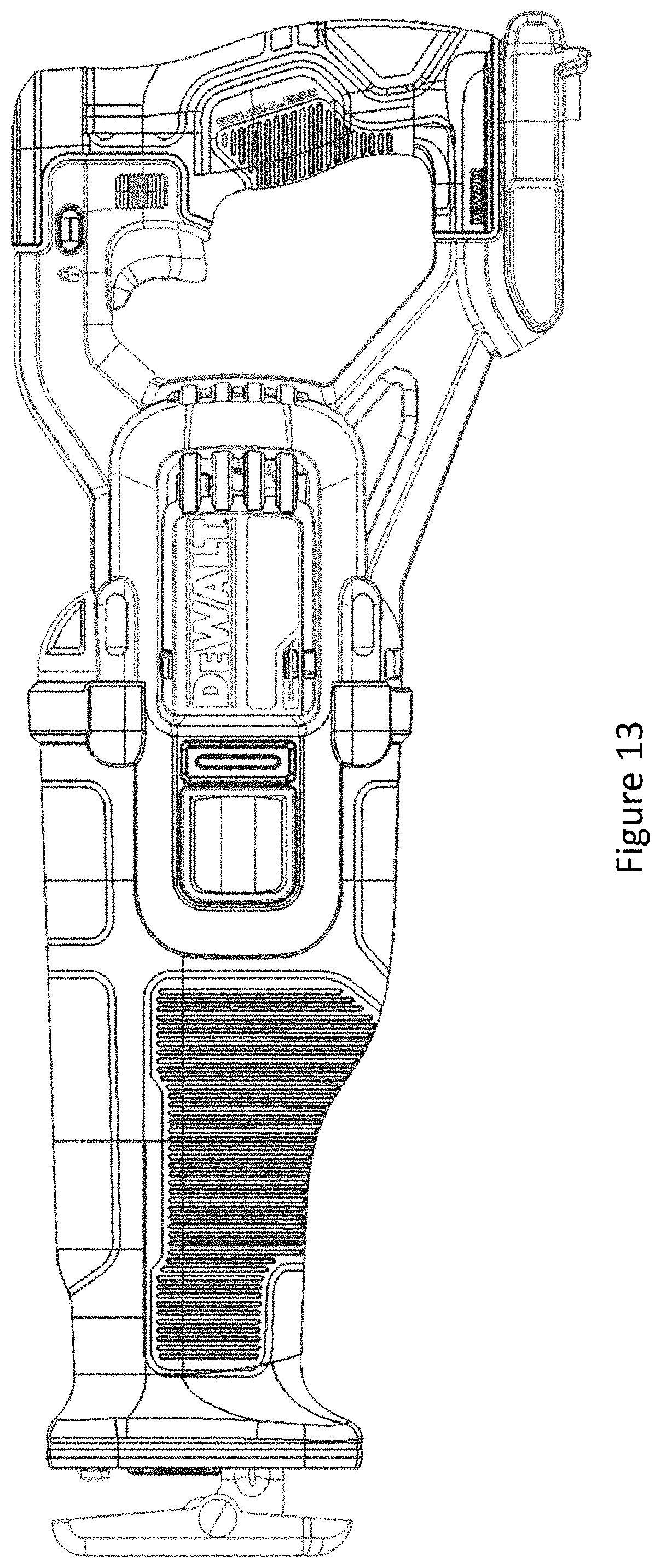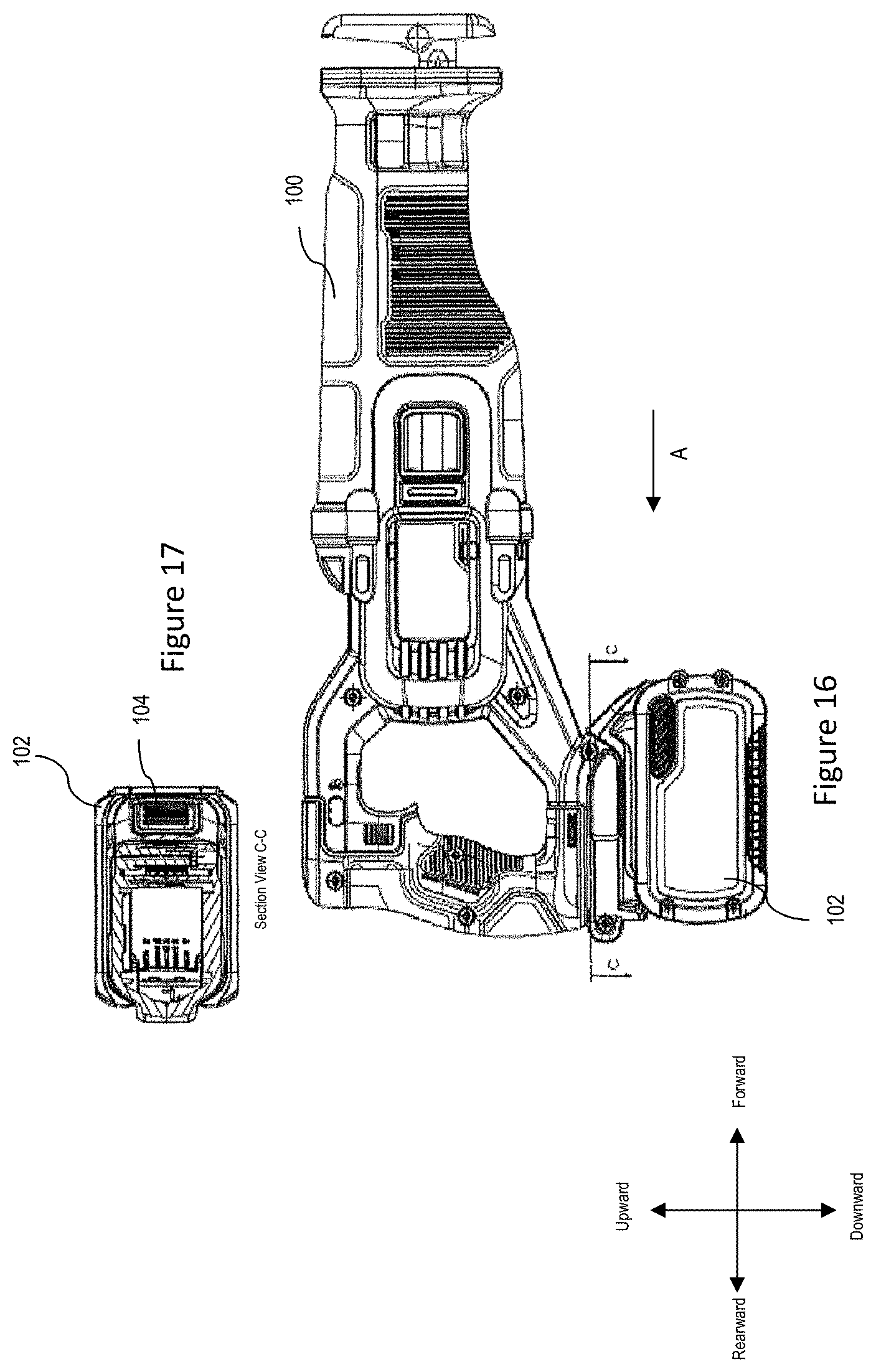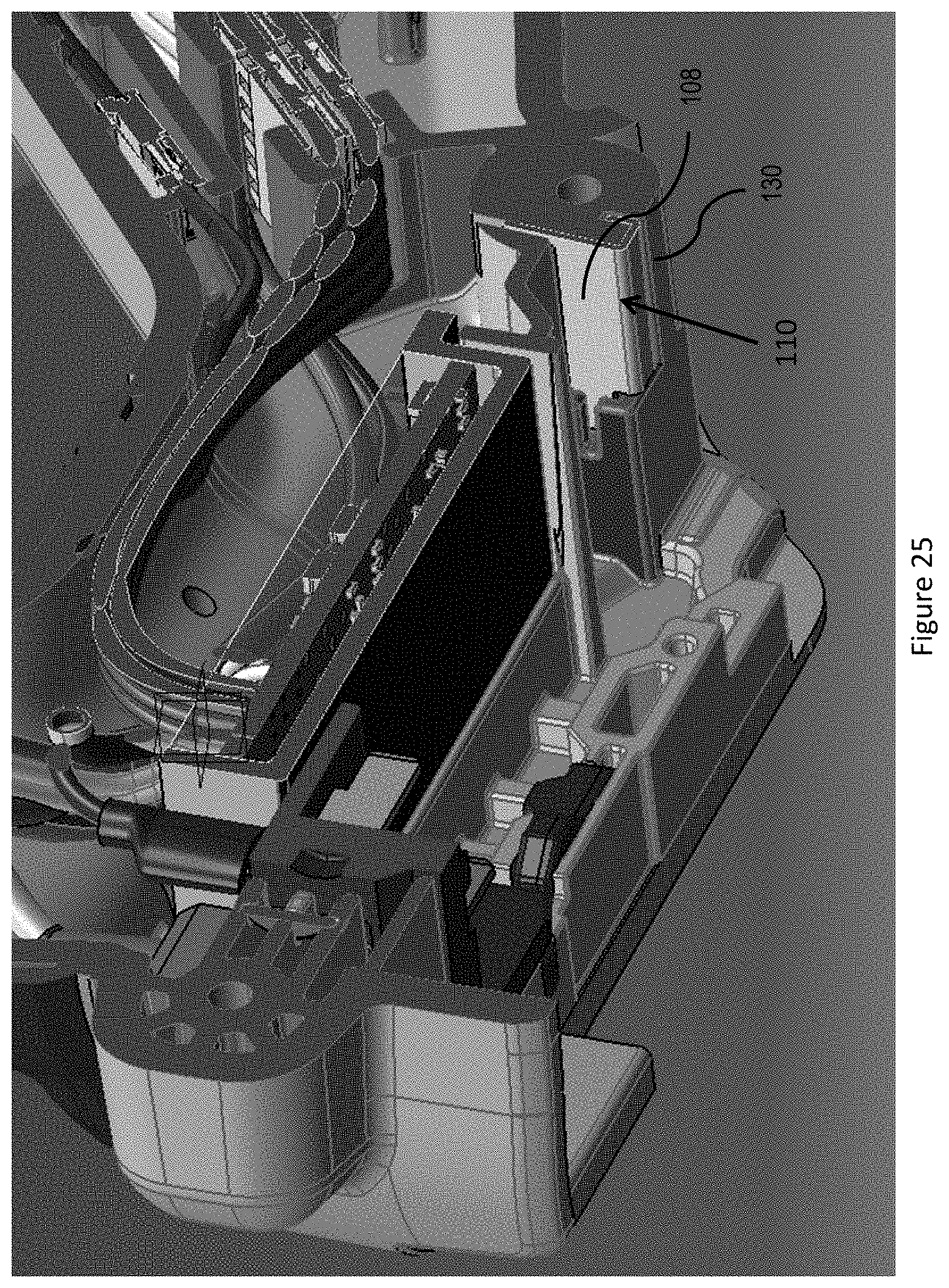Reciprocating saw
Krupsaw , et al.
U.S. patent number 10,625,410 [Application Number 15/628,306] was granted by the patent office on 2020-04-21 for reciprocating saw. This patent grant is currently assigned to Black & Decker, Inc.. The grantee listed for this patent is BLACK & DECKER INC.. Invention is credited to Christian V. Elder, William F. Gallagher, Nicholas J. Garibaldi, Benjamin Krupsaw, Nathan J. Osborne, Michael Varipatis, Paul S. White.












View All Diagrams
| United States Patent | 10,625,410 |
| Krupsaw , et al. | April 21, 2020 |
Reciprocating saw
Abstract
The present disclosure is directed to a cordless reciprocating saw including a mechanical interface for attaching a removable battery pack. The mechanical interface includes a strike plate to reduce the effects of vibrational forces on the battery pack.
| Inventors: | Krupsaw; Benjamin (Baltimore, MD), White; Paul S. (Ellicott City, MD), Varipatis; Michael (Fallston, MD), Osborne; Nathan J. (Baltimore, MD), Garibaldi; Nicholas J. (Baltimore, MD), Elder; Christian V. (Baltimore, MD), Gallagher; William F. (Stewartstown, PA) | ||||||||||
|---|---|---|---|---|---|---|---|---|---|---|---|
| Applicant: |
|
||||||||||
| Assignee: | Black & Decker, Inc. (New
Britain, CT) |
||||||||||
| Family ID: | 60660702 | ||||||||||
| Appl. No.: | 15/628,306 | ||||||||||
| Filed: | June 20, 2017 |
Prior Publication Data
| Document Identifier | Publication Date | |
|---|---|---|
| US 20170361448 A1 | Dec 21, 2017 | |
Related U.S. Patent Documents
| Application Number | Filing Date | Patent Number | Issue Date | ||
|---|---|---|---|---|---|
| 62352237 | Jun 20, 2016 | ||||
| Current U.S. Class: | 1/1 |
| Current CPC Class: | B25F 5/02 (20130101); B25F 5/006 (20130101) |
| Current International Class: | B25F 5/00 (20060101); B25F 5/02 (20060101) |
| Field of Search: | ;320/114 ;30/392 |
References Cited [Referenced By]
U.S. Patent Documents
| 4847513 | July 1989 | Katz |
| 6168881 | January 2001 | Fischer |
| 8228029 | July 2012 | Meyer |
| 2006/0199072 | September 2006 | Lui |
| 2008/0155834 | July 2008 | Li |
Attorney, Agent or Firm: Aronoff; Michael
Parent Case Text
RELATED APPLICATIONS
This application claims priority under 35 U.S.C. .sctn. 119(e) to U.S. Provisional Patent Application No. 62/352,237, filed Jun. 20, 2016, titled "Reciprocating Saw" which is incorporated by reference in its entirety.
Claims
The invention claimed is:
1. A reciprocating saw, comprising: a mechanical interface for receiving a battery pack including a latch having a forward facing surface, the mechanical interface including a catch for receiving the latch, the catch including a recess having a rearward facing surface; and a strike plate separate and discrete from the catch, the strike plate including an engagement arm, the engagement arm of the separate and discrete strike plate attached to the rearward facing surface of the recess to engage the forward facing surface of the latch, the engagement arm configured at an angle of 15 degrees to the latch forward facing surface when the battery pack is fully seated in the mechanical interface.
Description
TECHNICAL FIELD
This application relates to a cordless reciprocating saw. In one implementation, the reciprocating saw is configured to address the effects of vibrational forces on an attached battery pack.
BACKGROUND
As is well known, reciprocating saws produce significant vibration during operation. Certain cordless reciprocating saws rely on a removable battery pack to provide power to the motor. And certain of these cordless reciprocating saws produce significant vibrational forces in the same direction or in a direction very close to the direction that the battery pack is inserted to mate with the reciprocating saw. In these reciprocating saw/battery pack combinations sustained vibrational forces may overcome the attachment feature holding the battery pack on the reciprocating saw (typically a latch and a catch combination) and cause the battery pack to be ejected from the reciprocating saw.
SUMMARY
An aspect of the present invention includes a reciprocating saw including mechanical interface for coupling a removable battery pack. The mechanical interface includes a strike plate for reducing the effects of vibrational forces on the battery pack and to prevent the battery from inadvertently detaching from the reciprocating saw during operation.
A reciprocating saw, comprising a mechanical interface for receiving a battery pack including a latch having a forward facing surface, the mechanical interface including a catch for receiving the latch, the catch including a recess having a rearward facing surface; and a strike plate including an engagement arm attached to the rearward facing surface of the recess, the engagement arm configured at an angle of 15 degrees to the latch forward facing surface when the battery pack is fully seated in the mechanical interface.
These and other advantages and features will be apparent from the description and the drawings.
BRIEF DESCRIPTION OF THE DRAWINGS
FIG. 1 is a first perspective view of a reciprocating saw of the present disclosure.
FIG. 2 is a second perspective view of the reciprocating saw of FIG. 1.
FIG. 3 is a third perspective view of the reciprocating saw of FIG. 1.
FIG. 4 is a fourth perspective view of the reciprocating saw of FIG. 1
FIG. 5 is a fifth perspective view of the reciprocating saw of FIG. 1.
FIG. 6 is a sixth perspective view of the reciprocating saw of FIG. 1.
FIG. 7 is a seventh perspective view of the reciprocating saw of FIG. 1.
FIG. 8 is an eighth perspective view of the reciprocating saw of FIG. 1.
FIG. 9 is a ninth perspective view of the reciprocating saw of FIG. 1.
FIG. 10 is rear elevation view of the reciprocating saw of FIG. 1.
FIG. 11 is a first side elevation view of the reciprocating saw of FIG. 1.
FIG. 12 is a front elevation view of the reciprocating saw of FIG. 1.
FIG. 13 is a second side elevation view of the reciprocating saw of FIG. 1.
FIG. 14 is a top plan view of the reciprocating saw of FIG. 1.
FIG. 15 is a bottom plan view of the reciprocating saw of FIG. 1.
FIG. 16 is a first side view of the reciprocating saw of FIG. 1 coupled to a battery pack.
FIG. 17 is a section view along section line C-C of FIG. 16.
FIG. 18 is a top plan view of the reciprocating saw and battery pack of FIG. 16.
FIG. 19 is a section view along section line A-A of FIG. 18.
FIG. 20 is a detail view of the reciprocating saw and battery pack of FIG. 19.
FIG. 21 is a detail view of the reciprocating saw and battery pack of FIG. 20.
FIG. 22 is a perspective view of a strike plate of the present disclosure.
FIG. 23 is a side view of the strike plate of FIG. 22.
FIG. 24 is another detail view of the reciprocating saw and battery pack of FIG. 19.
FIG. 25 is a perspective partial section view of the reciprocating saw of FIG. 6.
FIG. 26 is a perspective view of a guide of the reciprocating saw of FIG. 1.
DETAILED DESCRIPTION
FIGS. 1 through 15 illustrate an exemplary embodiment of a new and improved reciprocating saw 100 of the present disclosure.
FIGS. 16 through 21 illustrate an exemplary embodiment of a new and improved reciprocating 100 saw coupled to a battery pack 102. The reciprocating saw 100 and the battery pack 102 include a cooperating mating interface that enables the battery pack 102 to electromechanically mate with the reciprocating saw 100. Mating interfaces in general in the cordless power tool industry for coupling a battery pack to a power tool are well known. An exemplary mating interface is illustrated and described in U.S. patent application Ser. No. 15/414,720, filed Jan. 25, 2017, which is incorporated herein by reference.
In the exemplary embodiment illustrated in FIGS. 16 and 19, the battery pack 102 is moved in a mating direction (arrow A) to couple with the reciprocating saw 100. The battery pack 102 includes a coupling button 104 and a latch 106. The saw 100 includes a catch 108 (typically in the form of a recess or a cavity) that receives the latch 106 when the battery pack 102 is fully seated or engaged with the saw 100. Upon sliding the battery pack 102 into engagement with the saw 100 (in direction A), a user could either depress the button 104 (downward) which in turn moves the latch 106 downward and allows the latch 106 to move past a forward shoulder 130 of the saw into the catch 108 or the simply slide the battery pack into engagement with the saw 100 and allow the shoulder 130 to force the latch 106 downward as the battery pack 102 slides into engagement and then allows the latch 106 to be received in the catch 108 when the battery pack 102 is fully seated with the saw 100.
In conventional systems, the battery pack latch includes a forward facing surface and the saw catch includes a rearward facing surface and upon full engagement of the battery pack and the saw the forward facing surface of the latch would abut the rearward facing surface of the catch to frictionally hold the battery pack on the saw. As noted above, during operation a reciprocating saw creates significant vibrational forces. In the configuration of the present reciprocating saw, a significant portion of the vibrational forces are in a direction opposite to the insertion direction A. As such, it is not uncommon for the latch to slide down rearward facing surface of the catch allowing the battery pack to eject from the saw.
To address this ejection issue, the saw 102 includes a strike plate 110. The strike plate 110 is attached to the rearward facing surface 122 of the catch 108. In the exemplary embodiment disclosed in FIGS. 19-25, the strike plate 110 is in the form of a J (illustrated backwards in FIGS. 20 and 24). The strike plate 110 includes an engagement arm 112 having an engagement surface, a connecting arm 114, and a catch arm 116. The engagement arm 112 is positioned in the cavity of the catch 108 and abuts the rearward facing surface 122 of the catch 108. The engagement surface of the engagement arm 112 abuts the forward facing surface 124 of the latch 106 when the battery pack 102 is fully seated. The catch arm 116 is received in a small cavity or recess 120 in the saw to hold the strike plate 110 in place. The connecting arm 114 connects the engagement arm 112 and the catch arm 116.
In a preferred embodiment, the engagement arm 112 is at an angle of 85 degrees from the connecting arm 114. Alternatively, the engagement arm 112 is at an angle of 85 degrees to the insertion direction A. Alternatively, the engagement arm 112 is at an angle of 15 degrees to the rearward facing surface 124 of the catch 106. These angles prevent the latch 106 from sliding downward along the rearward facing surface 122 of the catch 108.
In addition, the strike plate 110 having the aforementioned angles reduces wear on the battery latch 106 which would otherwise result from the sustained vibration during operation of the reciprocating saw 100.
FIG. 26 illustrates an exemplary embodiment of a crankshaft guide. The guide comprises two formed pieces. The guide is typically made of a metal. The first and second guide pieces include a first flange for attaching to the other piece. The first flange of each piece include at least one hole for receiving a fastener, such as a screw for connecting the two pieces. Each piece also includes a second flange. The second flange of each piece is configured to face the second flange of the other piece in a spaced, parallel relation when the two pieces are connected. The space between the two second flanges is such that the crankshaft fits therebetween. As such, a guide for the shaft is created.
This configuration enables simple manufacture of the guide, as the individual pieces are easily formed. This configuration also allows for easy repair of the saw if the guide or the crankshaft becomes damaged.
Numerous modifications may be made to the exemplary implementations described above. These and other implementations are within the scope of this application.
* * * * *
D00000

D00001

D00002

D00003

D00004

D00005

D00006

D00007

D00008

D00009

D00010

D00011

D00012

D00013

D00014

D00015

D00016

D00017

D00018

D00019

D00020

XML
uspto.report is an independent third-party trademark research tool that is not affiliated, endorsed, or sponsored by the United States Patent and Trademark Office (USPTO) or any other governmental organization. The information provided by uspto.report is based on publicly available data at the time of writing and is intended for informational purposes only.
While we strive to provide accurate and up-to-date information, we do not guarantee the accuracy, completeness, reliability, or suitability of the information displayed on this site. The use of this site is at your own risk. Any reliance you place on such information is therefore strictly at your own risk.
All official trademark data, including owner information, should be verified by visiting the official USPTO website at www.uspto.gov. This site is not intended to replace professional legal advice and should not be used as a substitute for consulting with a legal professional who is knowledgeable about trademark law.